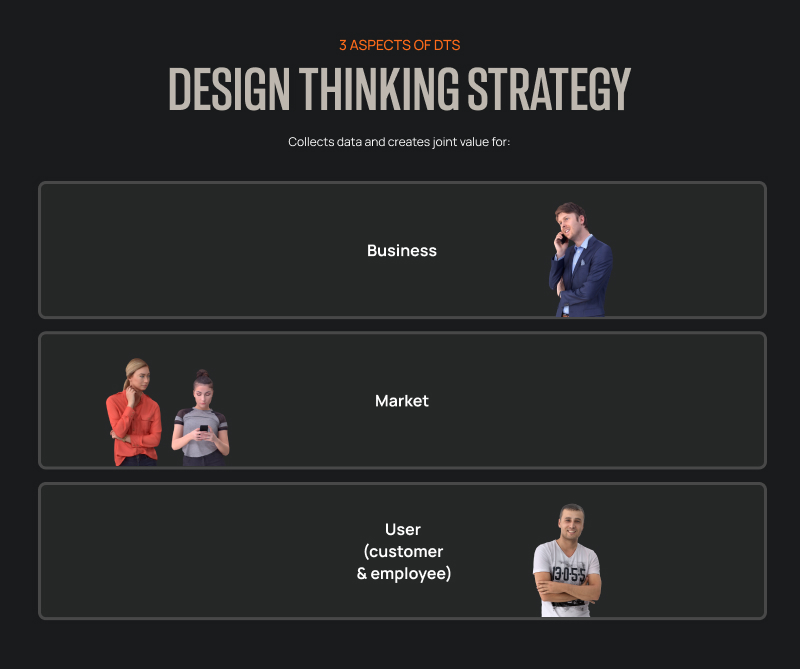How to select the right software services provider?
- July 25
- 28 min

Business transformation has many names. To make sure it doesn’t become a failure, companies turn to expert advice. Such offer a variety of tested methods, and one of them is Design Thinking. Learn why 78% of companies fail in business transformation, what are the four actors of business transformation and how to avoid a fiasco.
According to research by McKinsey 70% of digital transformations failed, most often due to resistance from employees.
Research by McKinsey shows the primary causes for business transformation failures:
At the heart of most failures is not technology. It’s the people.
To understand failure causes, first, you need to look at business transformation goals from different sides or the perspective of different actors.

#1. Stakeholders
What do stakeholders want? They want to improve company processes, build a brand and make money.
#2. Employees
What do employees expect? They expect to have an impact on the company’s actions, they want their work to not only give them satisfaction but also to give meaning to their lives.
#3. Customers
What do customers desire? They long for something authentic, something to bond with on the most personal level.
#4. Competitors
What do your competitors do? They are seeking a competitive advantage in the industry and trying to fill a niche in the market.
Organizations generally don’t create an environment conducive to business transformation where employees, stakeholders and customers are all heading towards the same direction.
First, let’s look at the organization’s perspective. Each department has a different set of solutions, considering only its own perspective. Individual departments rarely work together during a business transformation.
Instead, they focus on their own functional silos…
They identify themselves only with their department, compete with other departments, don’t have a complete overview of the company, work under pressure, focus on their functional silos because it’s more secure. They have no willingness to experiment, lose the sense of their work because they are tired of the constant struggle.

According to a study by Everest Group, as many as 78% of companies fail at their goals because they don’t include UX and market research into the business transformation.
In the process of digital transformation, the main focus usually is on the product, innovation, and digital technology. But, in the digital age, customers are the ones who decide about the product’s fate. If it doesn’t live up to their expectations, it will be quickly replaced with a user-centered alternative. To ensure a successful result, the primary focus should be switched from digital to experience transformation.
That’s why customers often choose the offer of competitive companies which help them to cover their needs and make them feel better.
In the simplest sense, use the data, care about others’ feelings and transform experiences (instead of following your good feeling).
Organizations generally don’t create an environment conducive to business transformation where employees, stakeholders and customers are heading towards the same direction.
Design Thinking Strategy creates exactly such an environment.

The goal of this strategy is to collect data, “listen” to the 3 voices: user, market and business, and then create a joint value.
Business transformation gains new meaning. It becomes an experience transformation that includes
Voice of Market – Market Research report, macroeconomic analysis, competition analysis, technology capabilities, failure case studies.
Voice of Business – Interviews with stakeholders, interviews with representatives of all involved departments or employees.
Voice of User (customer, employee) – UX Research with Users (customers and/or employees involved in the process): Qualitative and Quantitative research methods.
The winners are the organizations that engage stakeholders, employees and customers in the very early stages of the product and service development process. This allows them to focus and solve the right problem from a transformation perspective.
What is the right problem in the transformation process?
• Really painful
• Long lasting
• Has a specific owner (who is aware of the problem)
• His owner can’t use the sensible alternatives
• Concerns a large number of people
• Ideal: Easy to solve
If the right problem is defined you can discover the common vision of competitive advantage together with all departments and stakeholders.
Listening to the 3 voices:
Voice of Market – remember about the competitors, market research results, and technology limitations.
Voice of Business – list out limitations and expectations from the perspective of stakeholders and all involved departments.
Voice of User – prioritize User’s biggest needs, problems and challenges.
And last but not least: For each product, business or startup strategy a continuous optimization process should be implemented:
• Remember to set metrics and measures
• Collect the data from the users and the market again
• Check if you are going in the right direction
• Optimize the solution over and over again
• Still develop the product and never end
If you cannot measure something, you cannot improve it.
We are Hicron Software House. Our organization came from SAP, so we know the business pretty well.
By seeing the potential of making things and software more creative, we’ve decided to establish a different business unit fueled by custom software and design thinking strategy.
We transformed 300+ businesses and business processes for different companies from Automotive, Insurance, Real Estate, Retail, Life Science, Ecommerce, and many more industries.
